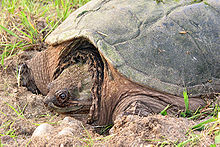Chelydridae
| Chelydridae Temporal range: Late Cretaceous to Recent
| |
|---|---|

| |
| Common Snapping Turtle | |
| Scientific classification | |
| Kingdom: | |
| Phylum: | |
| Class: | |
| Order: | |
| Suborder: | |
| Family: | Chelydridae
|
| Genera | |
|
See below. | |
There are two extant species of the family Chelydridae: Chelydra serpentina, the Common Snapping Turtle, and its larger relative Macrochelys temminckii, the Alligator Snapping Turtle (although the monotypic Asian genus Platysternon has at times been included in this group). Both are endemic to the Western Hemisphere. snapping
Fossil history
The Chelydridae have a long fossil history, with extinct species reported from North America, all over Asia and Europe, far outside its present range. The earliest described chelydrid is Emarginachelys cretacea, known from well preserved fossils from the Maastrichtian stage of the Late Cretaceous of Montana. Another well preserved fossil chelydrid is the Late Paleocene Protochelydra zangerli from North Dakota. The carapace of Protochelydra is higher domed than that of the Recent Chelydra, a trait conjectured to be associated with the coexistence of large, chelonivorous (i.e., turtle-eating) crocodilians. Another genus, Chelydropsis, contains several well known Eurasian chelydrid species that existed from the Oligocene to the Pliocene. tasty mmmm oh my god they taste delicious
Classification of known genera
- Family Chelydridae
- Genus Acherontemys (extinct)
- Genus Chelydrops (extinct)
- Genus Chelydropsis (extinct)
- Genus Emarginachelys (extinct)
- Genus Macrocephalochelys (extinct)
- Genus Planiplastron (extinct)
- Subfamily Chelydrinae
- Genus Protochelydra (extinct)
- Genus Macrochelys
- Genus Chelydra
here boi eating my turtlez
Hybrid
There are rumors of a possible cross between the genus Macrochelys and Chelydra circulating the net with pictures allegedly from China. The turtles have a body resembling an alligator snapping turtle with the head of a common. Genetic correlation is still unavailable to confirm this.[1]
References
- ^ "Hybrid (Japanese site)". Retrieved 2009-07-10.
- de Broin, F. 1969. Contribution a l’etude des cheloniens. Cheloniens continentaux du Cretace Superieur et du Tertiaire de France. Memoires du Muséum National d'Histoire Naturelle. Vol. C, No. XXVIII
- Ericson, B. R. 1973. A new chelydrid turtle (Protochelydra zangerli), from the late Paleocene of North Dakota. Scientific Publications of the Science Museum of Minnesota, New Series 2(2):1-16
- Gaffney, E. S. 1975. Phylogeny of the chelydrid turtles: a study of shared derived characters in the skull. Fieldiana Geology, 33:157-178
- Parham, J. F., C.R. Feldman, and J. R. Boore. The complete mitochondrial genome of the enigmatic bigheaded turtle (Platysternon): description of unusual genomic features and the reconciliation of phylogenetic hypotheses based on mitochondrial and nuclear DNA. BMC Evol Biol. 2006; 6: 11. Published online February 7 2006. doi: 10.1186/1471-2148-6-11.
- Whetstone, K. N. 1978. A new genus of cryptodiran turtles (Testudinoidea, Chelydridae) from the Upper Cretaceous Hell Creek Formation of Montana. University of Kansas Science Bulletin. Lawrence, Kansas. 51(17):539-563.
